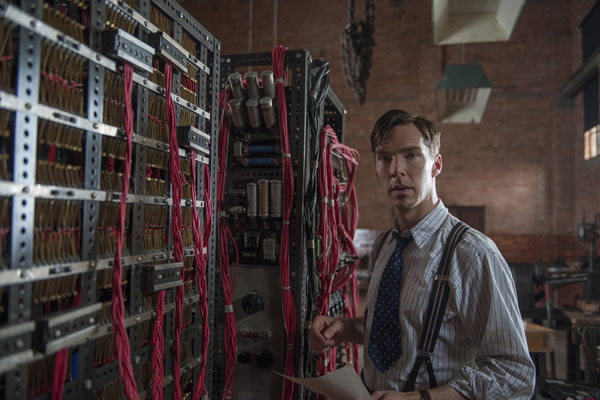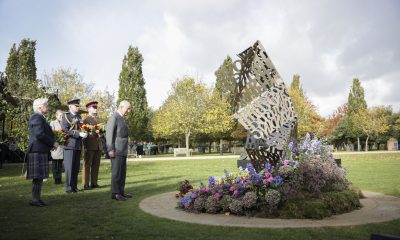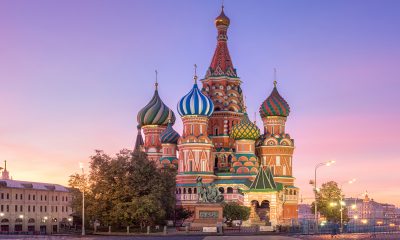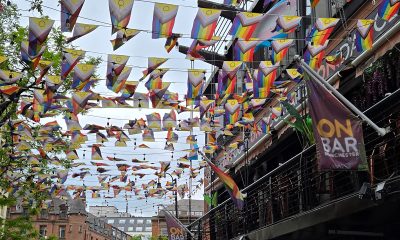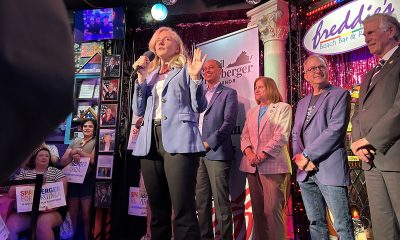a&e features
Turing tragedy
Gay genius finally gets due in big-screen feature
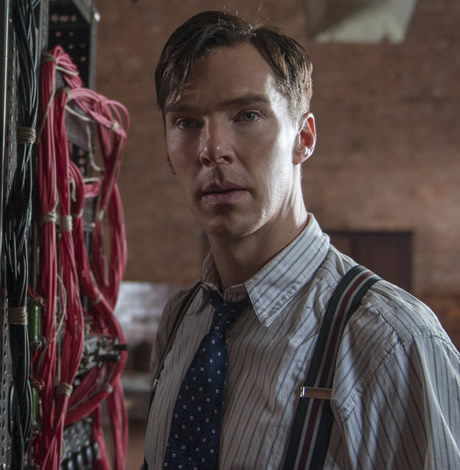
One of the most anticipated movies of the year has its roots in computer camp.
“The Imitation Game,” which had its area premiere at the Middleburg (Virginia) Film Festival last weekend and opens in Washington on Dec. 12, is about one of the most fascinating figures in 20th century history: Alan Turing, the gay cryptologist who broke the Nazi Enigma Code. Turing was an unsung hero of World War II and a victim of the legal and social turmoil that followed in its wake.
The movie’s director, Morten Tyldum, is fascinated by the man and his story.
“His achievements are so staggering,” Tyldum says. “Alan Turing theorized the computer in 1935 when he was 23 years old. He broke the Nazi Enigma machine which shortened the war by years and saved millions of lives. This man should have been on the front page of my history book when I was in school.”
Instead, Turing’s story was kept hidden for years. After the war, Tyldum explains, the newly formed British intelligence service MI6 hid Turing’s exploits from public view.
“They put the lid on it. Everything was kept secret. All the papers were burned and they threatened everyone to keep quiet about it. And then after the war he was persecuted for being a gay man.”
In 1952, Turing was arrested for acts of “gross indecency” and forced to undergo chemical castration.
The computer camp link comes from the movie’s screenwriter Graham Moore, who admits that he was a massive computer nerd when he was a teenager.
“I was obsessed with computer science,” Moore says. “I went to space camp. I went to math camp. I went to computer programming camp.”
Moore reveals that “among awkward nerdy teenage computer science dorks, Alan Turing is an object of intense fascination and cult-like devotion. He’s the patron saint of folks like me, the consummate outsider. And because he was an outsider in so many ways to his own society and to his own times, he was able to see the world in a way no one else did, and he was able to accomplish wonders that no one else thought were possible.”
Moore wanted to tell Turing’s story, but he thought the odds were against him.
“I dreamed my whole life about writing about him, but there’s this moment when you realize that a movie about a gay English mathematician in the 1940s who commits suicide will be unfinancable.”
Luckily, Moore met producers Nora Grossman and Ido Ostrowsky at a Hollywood party and the trio decided to make the movie.
They brought Norwegian director Morten Tyldum on board, and the pair had a period of six months to refine the script. They left Moore’s fascinating overall structure in place. He tells the story from three different vantage points: Turing’s experiences at boarding school where he falls in love with both his friend Christopher and the science of cryptography (the socially awkward Turing discovers he is better at deciphering codes than reading human emotions); Turing and his colleagues working at the top-secret Bletchley Park facility to break the unbreakable code; and, the aftermath of Turing’s arrest for homosexual acts.
According to Tyldum, this elegant structure turns the movie into an investigation.
“Alan Turing is a puzzle,” he says. “There is a mystery to him and we wanted the movie to jump back and forth between the most important moments in his life. It was a huge challenge to balance that, to make everything flow.”
As Tyldum and Moore worked to strengthen the overall story arc and to streamline individual scenes, they acted out the entire movie. When they worked on scenes between Turing (Benedict Cumberbatch) and Joan Clarke (Turing’s colleague and briefly his fiancé, played by Keira Knightley), Moore reveals, “I would always play Keira’s part and Morten would play Benedict’s part. We would do the scenes over and over again to try and find different ways to do things. We are very lucky that there is no photographic or video record of these rehearsals.”
Tyldum adds, “We had some really tender emotional moments between us. I think we were pretty good.”
In these sessions, Moore also played John Cairncross, a Scottish mathematician who was one of Turing’s codebreaking colleagues at Bletchley Park. That role eventually went to Irish actor Allen Leech, best known to American audiences for his role as the (former) chauffeur Branson in the wildly popular BBC series “Downton Abbey” and as the gay fashion designer Vincent in the indie release “Cowboys and Angels.”
Cairncross is a complex character with a secret of his own. Leech says, “It’s always great to play a character that has information that others don’t because knowledge is power. With Cairncross, there isn’t any shock or horror when he discovers that Turing is a homosexual. He just uses Turing’s secret to protect his own.”
Leech notes that the relationship between the two men was complicated. Leech points out, “I also think that he was a friend. He warns Turing that, ‘You can’t tell anyone. It’s illegal.’ It’s a genuine act of friendship. They’ve both committed acts that if they’re caught they could go to prison for.”
Once the script and the cast were in place, Tyldum led the company through an intense (and very short) eight-week shoot. “It was insane,” the director remembers. “We had to shoot fast and cover a lot of ground quickly. It was just very focused hard work.”
Many of the scenes were shot on the sites where they really occurred, including the interior scenes at Bletchley Park (which is now a museum). Leech says that was an incredible experience.
He says, “You could almost feel their presence, almost like their ghosts were in the room. Matthew Goode (who plays another of the codebreakers) kept saying, ‘If we dusted for fingerprints I’m pretty sure we could find Alan Turing in this building.’ The fact that all these amazing minds and all these wonderful people were there, it gives you a real sense of awe.”
Tyldum also emphasizes that they were able to use some of the real artifacts that Turing and his team used.
“We used the real Enigma machines,” Tyldum says. “There is something about touching those buttons. It’s a reminder that this really happened. It does something for the performers. It’s about the responsibility we have to do justice to the legacy of these people.”
Once the publicity tour is over, Moore goes back to his writing desk to finish his second novel. He’s the author of the New York Times bestseller “The Sherlockian” which weaves together the story of Arthur Conan Doyle and a contemporary investigator.
Tyldum is carefully searching for his next project.
“For my sake,” he says, “I want to make the right choice. You have to be in love with the project. If you can ever find a reason not to do it, don’t do it. It’s going to take years of your life.”
As for Allen Leech, he’s headed back to the English countryside to work with Maggie Smith and his cast mates on “Downton Abbey” After all, he says, “the big house isn’t going to take care of itself.”
Turing doc ‘Codebreaker’ still enjoying success
Out filmmaker Patrick Sammon, whose 2011 docudrama “Codebreaker” told the story of Alan Turing’s life, says he heard a big-screen Hollywood adaptation was planned on Turing but says the two projects are different enough that there’s no substantial overlap or conflict of interest.
“I don’t see it as competition at all,” Sammon, president of Story Center Productions, a documentary production company based in Washington, says. “The reality is that any Hollywood version tends to stray from the historical facts so we’ll see what happens. With ‘Imitation Game,’ hopefully, you know, they’ll stick mostly to the facts and I’m sure the message of Turing’s life will be conveyed. The bottom line is I see it as very complementary and the distribution companies are very excited. They think ‘Imitation Game’ will only increase interest in ‘Codebreaker’ and that’s often the case with a documentary when a Hollywood feature film gets made. … People who see it are more inclined to do some digging so it has the potential to draw more people to ‘Codebreaker.’”
Although Sammon’s 62-minute work was shown on TV in the U.K. and has been available on DVD and Netflix after a 2012 U.S. theatrical release, Sammon has been hosting screenings heavily ever since. He’s had 10 in the last six weeks and has more planned. His film has played in about 20 countries and been picked up as far away as China, Australia and New Zealand.
“I had hoped it would have a little bit of a shelf life because I thought the story was timeless,” he says. “Even though it’s been out awhile, it’s not a dated story and there’s always someone who’s new to the Alan Turing story.”
— JOEY DiGUGLIELMO
a&e features
Queer highlights of the 2026 Critics Choice Awards: Aunt Gladys, that ‘Heated Rivalry’ shoutout and more
Amy Madigan’s win in the supporting actress category puts her in serious contention to win the Oscar for ‘Weapons’

From Chelsea Handler shouting out Heated Rivalry in her opening monologue to Amy Madigan proving that horror performances can (and should) be taken seriously, the Critics Choice Awards provided plenty of iconic moments for queer movie fans to celebrate on the long road to Oscar night.
Handler kicked off the ceremony by recapping the biggest moments in pop culture last year, from Wicked: For Good to Sinners. She also made room to joke about the surprise hit TV sensation on everyone’s minds: “Shoutout to Heated Rivalry. Everyone loves it! Gay men love it, women love it, straight men who say they aren’t gay but work out at Equinox love it!”
The back-to-back wins for Jacob Elordi in Frankenstein and Amy Madigan in Weapons are notable, given the horror bias that awards voters typically have. Aunt Gladys instantly became a pop culture phenomenon within the LGBTQ+ community when Zach Cregger’s hit horror comedy released in August, but the thought that Madigan could be a serious awards contender for such a fun, out-there performance seemed improbable to most months ago. Now, considering the sheer amount of critics’ attention she’s received over the past month, there’s no denying she’s in the running for the Oscar.
“I really wasn’t expecting all of this because I thought people would like the movie, and I thought people would dig Gladys, but you love Gladys! I mean, it’s crazy,” Madigan said during her acceptance speech. “I get [sent] makeup tutorials and paintings. I even got one weird thing about how she’s a sex icon also, which I didn’t go too deep into that one.”
Over on the TV side, Rhea Seehorn won in the incredibly competitive best actress in a drama series category for her acclaimed performance as Carol in Pluribus, beating out the likes of Emmy winner Britt Lower for Severance, Carrie Coon for The White Lotus, and Bella Ramsey for The Last of Us. Pluribus, which was created by Breaking Bad’s showrunner Vince Gilligan, has been celebrated by audiences for its rich exploration of queer trauma and conversion therapy.
Jean Smart was Hack’s only win of the night, as Hannah Einbinder couldn’t repeat her Emmy victory in the supporting actress in a comedy series category against Janelle James, who nabbed a trophy for Abbott Elementary. Hacks lost the best comedy series award to The Studio, as it did at the Emmys in September. And in the limited series category, Erin Doherty repeated her Emmy success in supporting actress, joining in yet another Adolescence awards sweep.
As Oscar fans speculate on what these Critics Choice wins mean for future ceremonies, we have next week’s Golden Globes ceremony to look forward to on Jan. 11.
a&e features
Looking back at the 10 biggest A&E stories of 2025
‘Wicked,’ Lady Gaga’s new era, ‘Sexy’ Bailey and more

Although 2025 was a year marked by countless attacks on trans rights and political setbacks, the year also saw brilliant queer artists continuing to create art. From Cannes and Sundance Award winners now vying for Oscar consideration to pop icons entering new stages of their careers, queer people persevered to tell their stories through different media.
With the state of the world so uncertain, perhaps there’s no more vital time to celebrate our wins, as seen through some of this year’s top pop culture moments. While there’s no collection of 10 stories that fully encompass “the most important” news, here are some events that got the gays going:
10. ‘Mysterious Gaze of the Flamingo’ wins big at Cannes

The Cannes Film Festival has become a crucial start for films hoping to make their way to the Oscars, and first-time director Diego Céspedes won the top Un Certain Regard prize for his intimate western “The Mysterious Gaze of the Flamingo.” The film is set in the ‘80s and is intended as an allegory for the AIDS epidemic. Seeing a film that unpacks vital queer history win one of the most coveted awards at Cannes has been a huge point of pride in the independent filmmaking community.
Since the film bowed at Cannes, it has been selected as Chile’s Oscar entry in the Best International Feature race. Speaking with The Blade during the film’s AFI Fest run in October, Céspedes said: At first, I was kind of scared to have this campaign position in the times that we’re living [in] here. But at the same time, I think the Oscars mean a huge platform — a huge platform for art and politics.”
9. ‘The Last of Us’ returns for an even gayer season 2
While the first season of The Last of Us gave us one of TV’s most heartbreaking queer love stories in the episode “Long, Long Time,” Season 2 doubled down on its commitment to queer storytelling with the blossoming relationship between Ellie (Bella Ramsey) and Dina (Isabela Merced). The show expanded on the pair’s relationship in the original video game, making it perhaps the central dynamic to the entire season. That unfortunately came with more homophobic backlash on the internet, but those who checked out all the episodes saw a tender relationship form amid the show’s post-apocalyptic, often violent backdrop. For their performance, Ramsey was once again nominated for an Emmy, but Merced deserved just as much awards attention.
8. ‘Emilia Pérez’ sparks controversy
Jacques Audiard’s genre-bending trans musical “Emilia Pérez” proved to be an awards season juggernaut this time last year, winning the Golden Globe for Best Musical/Comedy. But when the lead star Karla Sofia Gascón’s racist, sexist, and homophobic old tweets resurfaced, the film’s Oscar campaign became a tough sell, especially after Netflix had tried so hard to sell Emilia Pérez as the “progressive” film to vote for. Mind you, the film had already received significant backlash from LGBTQ+ audiences and the Mexican community for its stereotypical and reductive portrayals, but the Gascón controversy made what was originally just social media backlash impossible to ignore. The only person who seemed to come out of the whole debacle unscathed was Zoe Saldaña, who won the Oscar for Best Supporting Actress over Ariana Grande.
7. ‘Sorry, Baby’ establishes Eva Victor as major talent
Back in January at the Sundance Film Festival, Eva Victor (known by many for her brand of sketch comedy) premiered their directorial debut “Sorry, Baby” to rave reviews, even winning the Waldo Salt Screening Award. Victor shadowed Jane Schoenbrun on the set of “I Saw the TV Glow,” and seeing Victor come into their own and establish such a strong voice immediately made them one of independent cinema’s most exciting new voices. A memorable scene in the film sees the main character, Agnes (played by Victor), struggling to check a box for male or female, just one example of how naturally queerness is woven into the fabric of the story.
Most recently, Victor was nominated for a Golden Globe for her performance in the film, and she’s represented in a category alongside Jennifer Lawrence (“Die My Love”), Jessie Buckley (“Hamnet”), Julia Roberts (“After the Hunt”), Renate Reinsve (“Sentimental Value”) and Tessa Thompson (“Hedda”). The film also received four Independent Spirit Award nominations overall.
6. Paul Reubens comes out in posthumous doc

While Paul Reubens never publicly came out as gay before passing away in 2023, the two-part documentary “Pee-wee as Himself” premiered back in May on HBO Max, giving the legendary comedian a chance to posthumously open up to the world. Directed by Matt Wolf, the documentary explores how Reubens found his alter ego Pee-Wee Herman and why he kept his private life private.
The documentary won an Emmy in the Outstanding Documentary or Nonfiction Special category and remains one of the most critically acclaimed titles of the year with a 100% Rotten Tomatoes score. Also worth noting, the National Geographic documentary Sally told the posthumous coming out story of Sally Ride through the help of her long-time partner, Tam O’Shaughnessy.
5. Lady Gaga releases ‘Mayhem’
Lady Gaga entered a new phase of her musical career with the release of Mayhem, her seventh album to date. From the frenzy-inducing pop hit Abracadabra to the memorable Bruno Mars duet featured on “Die With a Smile,” seeing Gaga return to her roots and make an album for the most die-hard of fans was especially rewarding after the underwhelming film releases of “House of Gucci” and “Joker: Folie à Deux.” Gaga has been touring with The Mayhem Ball since July, her first arena tour since 2018. She even extended her tour into 2026 with more North American dates, so the party isn’t stopping anytime soon. And Gaga is even set to make an appearance next May in “The Devil Wears Prada 2.”
4. Cynthia Erivo, Ariana Grande perform at the Oscars

While “Wicked: For Good” didn’t quite reach the heights of the first film, we will forever have Cynthia Erivo and Ariana Grande’s breathtaking live performance that opened the 97th Academy Awards. The pair sang a rendition of “Over the Rainbow,” “Home,” and “Defying Gravity,” paying proper homage to the original 1939 “Wizard of Oz.” Even non-Wicked fans can’t deny how magical and brilliantly staged this performance was. With both Erivo and Grande up for acting Oscars last year, they’re hoping to repeat success and make history with consecutive nominations. Either way, let’s hope there’s another live performance in the making, especially with two new original songs (The Girl in the Bubble and No Place Like Home) in the mix.
3. Indya Moore speaks out against Ryan Murphy
Indya Moore has consistently used social media as a platform for activism, and in September, posted a 30-minute Instagram live speaking out against “Pose” co-creator Ryan Murphy. Moore claimed that Murphy wasn’t being a true activist for trans people. “Ryan Murphy, we need you to do more. You need to address the racism, the violence, and the targeting of people on your productions, Ryan Murphy. You do need to make sure trans people are paid equally. Yes, Janet did the right thing,” Moore said. Murphy was also back in the headlines this year for the critically panned “All’s Fair” and the controversial “Monster: The Ed Gein Story” starring Laurie Metcalf and Charlie Hunnam.
2. Cole Escola wins Tony for Best Leading Actor
Few pop culture moments this year brought us together more than Cole Escola winning a Tony award for “Oh, Mary!” the Broadway show they created, wrote and starred in (we love a triple threat!) Escola made history by becoming the first nonbinary person to win a Tony in the leading actor category, and seeing them excitedly rush to the stage wearing a Bernadette Peters-inspired gown instantly became a viral social media moment.
The cherry on top of Escola’s major moment is the recent news that they are writing a Miss Piggy movie with Jennifer Lawrence and Emma Stone producing — news that also broke the internet for the better. We cannot wait!
1. Jonathan Bailey makes gay history as ‘Sexiest Man Alive’

The same year as his on-screen roles in blockbusters “Jurassic World Rebirth” and “Wicked: For Good,” Jonathan Bailey made history as the first openly gay man to be named People magazine’s “Sexiest Man Alive.” The fact that it took 40 years for an openly gay man to earn the title is a signifier of how far we still have to go with queer representation, and seeing Bailey celebrated is just one small step in the right direction.
“There’s so many people that want to do brilliant stuff who feel like they can’t,” he told PEOPLE, “and I know the LGBT sector is under immense threat at the moment. So it’s been amazing to meet people who have the expertise and see potential that I could have only dreamed of.” In 2024, Bailey founded the charity titled The Shameless Fund, which raises money for LGBTQ+ organizations.
a&e features
Your guide to D.C.’s queer New Year’s Eve parties
Ring in 2026 with drag, leather, Champagne, and more

With Christmas in the rear view mirror, we can turn our attention to ringing in a much-anticipated New Year with a slew of local LGBTQ parties. Here’s what’s on tap.
Pitchers
This spacious Adams Morgan bar is hosting the “Pitchers’ Perfect New Year’s Eve.” There will be a midnight Champagne toast, the ball drop on the big screens, and no cover, all night long. The bar doesn’t close until 4 a.m., and the kitchen will be open late (though not until close). All five floors will be open for the party, and party favors are promised.
Trade
D.C.’s hottest bar/club combo is leaning into the Shark motif with its NYE party, “Feeding Frenzy.” The party is a “glitterati-infused Naughty-cal New Year’s Even in the Shark Tank, where the boats are churning and the sharks are circling.” Trade also boasts no cover charge, with doors opening at 5 p.m. and the aforementioned Shark Tank opening at 9 p.m.. Four DJs will be spread across the two spaces; midnight hostess is played by Vagenesis and the two sea sirens sensuously calling are Anathema and Justin Williams.
Number Nine
While Trade will have two DJs as part of one party, Number Nine will host two separate parties, one on each floor. The first floor is classic Number Nine, a more casual-style event with the countdown on TVs and a Champagne midnight toast. There will be no cover and doors open at 5 p.m. Upstairs will be hosted by Capital Sapphics for its second annual NYE gathering. Tickets (about $50) include a midnight Champagne toast, curated drink menu, sapphic DJ set by Rijak, and tarot readings by Yooji.
Crush
Crush will kick off NYE with a free drag bingo at 8 p.m. for the early birds. Post-bingo, there will be a cover for the rest of the evening, featuring two DJs. The cover ($20 limited pre-sale that includes line skip until 11 p.m.; $25 at the door after 9 p.m.) includes one free N/A or Crush, a Champagne toast, and party favors (“the legal kind”). More details on Eventbrite.
Bunker
This subterranean lair is hosting a NYE party entitled “Frosted & Fur: Aspen After Dark New Year’s Eve Celebration.” Arriety from Rupaul Season 15 is set to host, with International DJ Alex Lo. Doors open at 9 p.m. and close at 3 p.m.; there is a midnight Champagne toast. Cover is $25, plus an optional $99 all-you-can-drink package.
District Eagle
This leather-focused bar is hosting “Bulge” for its NYE party. Each District Eagle floor will have its own music and vibe. Doors run from 7 p.m.-3 a.m. and cover is $15. There will be a Champagne toast at midnight, as well as drink specials during the event.
Kiki, Shakiki
Kiki and its new sister bar program Shakiki (in the old Shakers space) will have the same type of party on New Year’s Eve. Both bars open their doors at 5 p.m. and stay open until closing time. Both will offer a Champagne toast at midnight. At Kiki, DJ Vodkatrina will play; at Shakiki, it’ll be DJ Alex Love. Kiki keeps the party going on New Year’s Day, opening at 2 p.m., to celebrate Kiki’s fourth anniversary. There will be a drag show at 6 p.m. and an early 2000s dance party 4-8 p.m.
Spark
This bar and its new menu of alcoholic and twin N/A drinks will host a NYE party with music by DJ Emerald Fox. Given this menu, there will be a complimentary toast at midnight, guests can choose either sparkling wine with or without alcohol. No cover, but Spark is also offering optional wristbands at the door for $35 open bar 11 p.m.-1 a.m. (mid-shelf liquor & all NA drinks).
-

 District of Columbia4 days ago
District of Columbia4 days agoTwo pioneering gay journalists to speak at Thursday event
-

 Colombia4 days ago
Colombia4 days agoBlade travels to Colombia after U.S. forces seize Maduro in Venezuela
-

 a&e features4 days ago
a&e features4 days agoQueer highlights of the 2026 Critics Choice Awards: Aunt Gladys, that ‘Heated Rivalry’ shoutout and more
-

 Virginia4 days ago
Virginia4 days agoLGBTQ groups to join Spanberger inaugural parade

